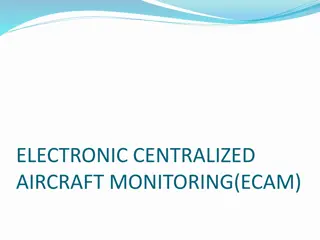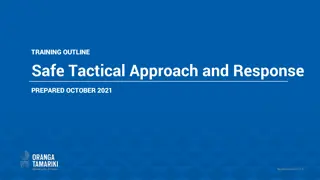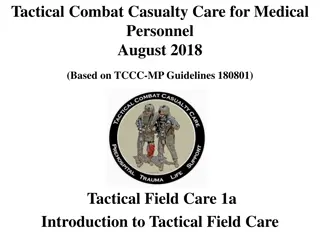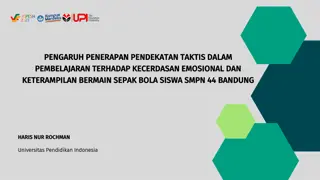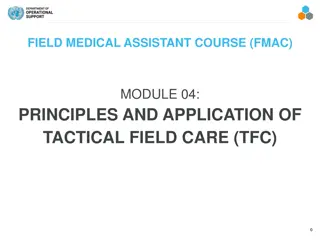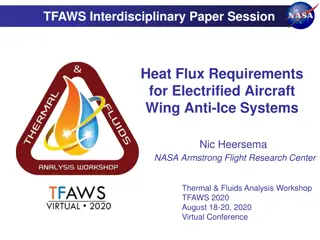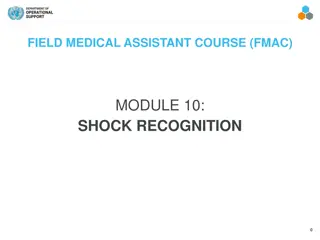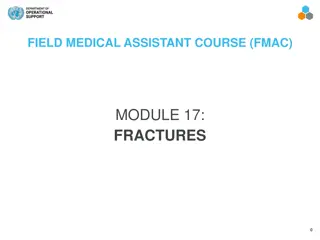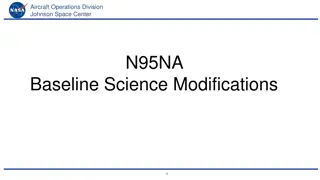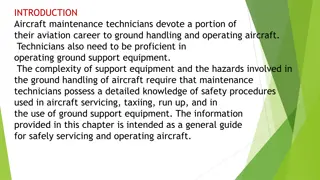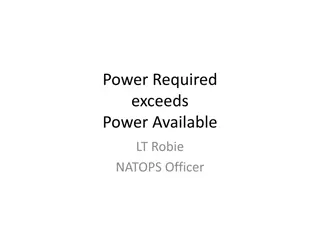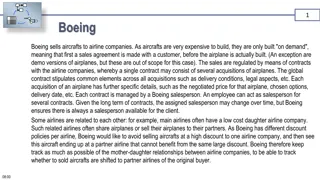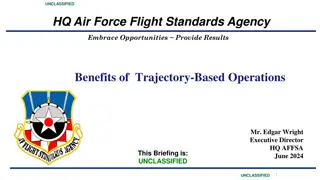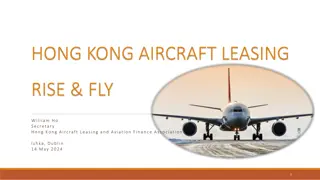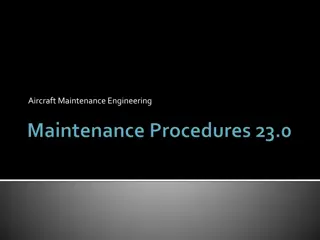Tactical Formation Maneuvering for T-44C Aircraft
This presentation provides essential knowledge for conducting tactical formation flights in the T-44C aircraft, covering formation types, fundamentals, maneuvers, and division formations. It outlines the importance of formation unity, maneuverability, and coordination, along with considerations like METT-TSL factors. The content emphasizes understanding different formation elements and sizes for mission accomplishment.
Download Presentation

Please find below an Image/Link to download the presentation.
The content on the website is provided AS IS for your information and personal use only. It may not be sold, licensed, or shared on other websites without obtaining consent from the author.If you encounter any issues during the download, it is possible that the publisher has removed the file from their server.
You are allowed to download the files provided on this website for personal or commercial use, subject to the condition that they are used lawfully. All files are the property of their respective owners.
The content on the website is provided AS IS for your information and personal use only. It may not be sold, licensed, or shared on other websites without obtaining consent from the author.
E N D
Presentation Transcript
Tiltrotor Tactical Formation Maneuvering Click to Add Instructor Name
This Presentation is Classified: UNCLASSIFIED
Purpose The purpose of this presentation is to provide the student with the requisite knowledge to conduct tactical formation flight in the T-44C.
Learning Objectives Identify the method to determine what type of formation to choose Identify the different types of formation for the T-44C Describe tactical formation fundamentals Identify and describe tactical formation maneuvers Identify and describe division formations
Outline Formation Description and Objectives Formation Types Tactical Formation Basics Tactical Formation Maneuvers Division Formations
Outline Formation Description and Objectives Formation Types Tactical Formation Basics Tactical Formation Maneuvers Division Formations
Formation Description Maneuver Element smallest element of a flight that may engage in independent maneuver during tactical evolutions Section = 2 aircraft, single maneuver element, smallest, basic component towards construction of larger formation, easiest C&C, and most flexible Division = 3 or 4 aircraft, largest maneuver element or two sections Flight = 2 or more maneuver elements / 5 or more aircraft
Formation Description Unity of effort for mission accomplishment Maneuverability and flexibility Mutually supportive lookout doctrine Ease of control and coordination There is an optimum size for every formation
Considerations METT-TSL Mission Enemy (Threat) Terrain and Weather Troops and Fire Support Time Space Logistics
Outline Formation Description and Objectives Formation Types Parade Cruise Tactical Tactical Formation Basics Tactical Formation Maneuvers Division Formations
Formation Types Parade Fixed bearing (45 ) and distance Cruise Varying bearing and distance using radius of turn between the 30-45 bearings at 0.0-0.2 DME Tactical (Combat) Combat Cruise radius of turn Combat Spread Tactical Formation Maneuvers (TFM) and flight leadership
Combat Cruise 30-45 bearing on either side of lead 5 or 7 oclock Separation: 0.3 to 1.0 NM 10 10 0.1NM 0.1 NM 0.2NM 0.3 NM 0..5NM 0..5 NM 1.0NM 1.0 NM 45 45 Transitory Transitory 30 30
Combat Spread +10 bearing either side of lead Abeam position Separation 0.3 to 2.0 NM +10 +10 -10 -10 0.5 NM 2.0 NM
Combat Spread Why do we have this? Unsure of enemy location Don t want to alert enemy for a second shot More time focused on identifying threat / hazard than avoiding lead Wider field of view / mutual support One shot does not equal two kills
Outline Formation Description and Objectives Formation Types Tactical Formation Basics Tactical Formation Maneuvers Division Formations
TACFORM Basic Principles Wingman responsible for separation Employ adequate intraflight separation to ensure single target engagement and facilitate maneuver flexibility while maintaining mutual support Maneuver in proportion to threat Wingmen are always working to maintain position. Lead is always working to facilitate wingmen maintaining position.
TACFORM Energy Management Awareness and preservation of the aircraft energy state during a series of maneuvers Potential energy Energy based upon position (altitude, Qm) Kinetic energy Energy based upon motion (airspeed) Energy continuously changes states Airspeed to altitude in climb (kinetic to potential) Altitude to airspeed in dive (potential to kinetic)
TACFORM Maneuver Contracts All maneuvers are called from Combat Spread Airspeed 180KIAS All Turns at 45 AOB (except check turns) Rollout headings will be called for every maneuver despite degrees of turn assumed Command of execution is when Dash-2 says TWO Dash-2 is always the one who steps up when warranted (cross turn)
TACFORM Successful Execution Relative positioning within the element prior to execution Geometries of the planned maneuver relative to tactical considerations (terrain, conditions, threat) Desired relative position following maneuver completion Takes SA, flight leadership, and good airwork by both aircraft
Outline Formation Description and Objectives Formation Types Tactical Formation Basics Tactical Formation Maneuvers Division Formations
Shackle Initiate change of sides within formation Tactical necessity (clear 6 o clock) Moderately slow downrange travel Primarily used to Assist wingman regain position (excessive separation and/or sucked) Maintain energy and course or in conjunction with a moderate course change
Shackle Turn towards flight 45 heading change May require more turn by lead and less by wing, or vice versa, so don t get set on a specific heading change Stingray 62, shackle / shackle left / right 030 Resume course at cross and judge turn to regain separation The aircraft with the most SA will call Resume In this fleet, the crew chief will do this for you
Shackle <45 HeadingChange 45 HeadingChange 45 HeadingChange <45 HeadingChange
Tac-Turns Change the direction of the element right / left 60-120 (90 assumed) Direct the execution of a planned route turn Modify element orientation towards a more positive flight condition Types Turns Into Wingman Turns Away From Wingman Aircraft on outside of turn always turns first Stingray 62, tac-left/right, 090
Tac-Turns C C D D B B B B D C C D A A A A Into Wingman Away From Wingman
Pump Immediately stop downrange closure on an obstacle, weather condition or threat system 90 left / right heading change Stingray 62, Pump left / right, 270 Normally followed by pump back to original heading No resume call Separation retained in trail Threat Ring Pump Right Pump Left
Hook Turn Change orientation of element 120-240 Towards a threat in engagement parameters in rear quadrant Away from threat outside of engagement parameters in forward quadrant Established intra-flight separation maintained Displaces element 1.5 NM right / left of original courseline Stingray 62, Hook left / right, 180 Threat Ring
Split Turn Change orientation of element 120-240 Hard Turn executed away from other element aircraft Increased intra-flight separation results (3 NM or more) Stingray 62, Split, 180 3 NM+
Cross Turn Change orientation of element 120-240 Hard Turn executed towards other element aircraft Intra-flight separation based upon entrance separation Avoid 2.5-3.0 NM 1.5 NM away at initiation yields 1.5 NM separation Stingray 62, Cross, 180 Moderate AOB Avoid 2.5-3.5 NM
Dig / Pinch Adjust lateral separation within element while maintaining course orientation Hard turn with 30-45 Heading change Stingray 62, Dig / Pinch / Resume Dig 30-45 Heading Change Pinch
Check Turn Adjusts flight orientation for heading changes of 30 or less Execute SRT, simultaneous, no change of sides Stingray 62, Check right / left 030 0 - 45
Other 45 AOB turn at 180 KCAS results in a radius of turn of approx. 1.3 NM? Cover can be added to any maneuver (Dash-2) Adjust AOB, turn, altitude to manage position / separation Lead rollout for proper separation by .2 - .4 NM
Contracts (cont) Wingman is always working towards proper bearing and separation Element aircraft will not continue a maneuver unless visual contact is established by at least one aircraft in the section If aircraft is blind call wingman; expect a: visual / continue or blind / terminate Rollouts assume 90 / 180 turns
Outline Formation Description and Objectives Formation Types Tactical Formation Basics Tactical Formation Maneuvers Division Formations
Division Combat Cruise - Sections in Combat Cruise 0.5 NM 0.5 NM Balances Flight 45 45 Heavy Left 30 30
Fluid Four Flight in Combat Spread Sections in Combat Cruise Wingman on outside Wingman change sides during large turns to remain on outside using radius of turn Fluid Four (-) Spread No. 1 No. 3 No. 2 No. 4
Summary Formation Description and Objectives Formation Types Tactical Formation Basics Tactical Formation Maneuvers Division Formations
This Presentation is Classified: UNCLASSIFIED



